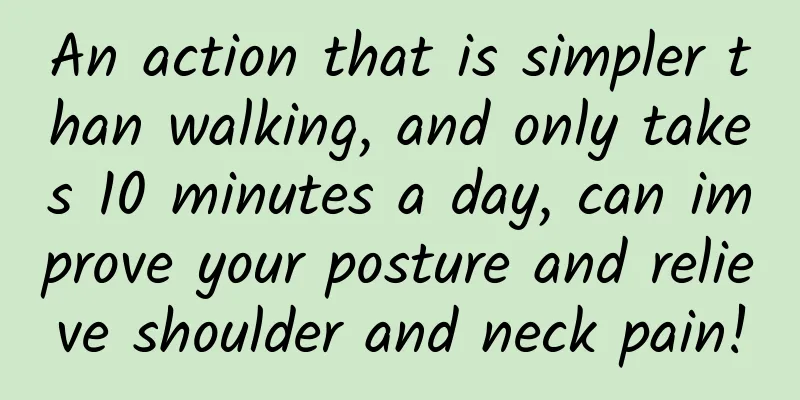An action that is simpler than walking, and only takes 10 minutes a day, can improve your posture and relieve shoulder and neck pain!

|
Standing against a wall is one of the most popular fitness methods nowadays. According to many bloggers, it is simple and easy to do and has many benefits. "It can correct body posture, relieve shoulder, neck and waist pain, strengthen lower limb joints, and even reduce weight and fat, and prevent cardiovascular diseases..." Can standing against a wall really bring so many health benefits? Today we will have a good chat to separate the truth from the false. Standing against the wall These benefits are real Modern urban people mainly do mental work, and sitting for long periods of time is the norm, which causes the unbalanced pressure on the spine from the neck to the waist to increase day by day . In order to maintain a longer period of sitting, the posture will compensate and form a bad posture with the head extended forward, rounded shoulders and hunched back, and the buttocks and belly sticking out . Academically, it is called "upper cross syndrome" and "lower cross syndrome". Upper cross syndrome and lower cross syndrome. The picture comes from the Internet Not only that, sedentary behavior has become one of the independent risk factors for chronic diseases, and is associated with cardiovascular disease, type 2 diabetes, obesity, metabolic syndrome and even premature death. Standing is a simple way to replace sitting , which can reduce the harm of sitting to a certain extent and has certain health benefits for the heart. Compared with long periods of sitting, the benefits of standing and walking are clear. (Healy GN, et al. 2015) Moreover, standing consumes more energy per minute than sitting. Studies have found that standing consumes more energy than lying or sitting, and this is more obvious in obese people (of course, walking consumes the most energy). Comparison of energy consumption of different exercise habits between thin and fat people (JA Levine et al, 2005) Note: TEF: Thermic effect of food; NEAT: Non-exercise activity thermogenesis; BMR: Basal metabolic rate But for people who don't have the habit of exercising, standing alone may be very tiring, and they may become crooked after standing for a while. Standing against a wall is relatively easier and more friendly to those who are just starting to correct their sedentary habits. Therefore, as an entry-level operation for beginners to develop good habits, standing against a wall is a good choice. When standing against a wall, the back against the wall provides the body with spatial and positional feedback, enhancing the body's awareness of correct posture, activating the deep cervical flexors, middle and lower trapezius muscles, and multifidus and transverse abdominal muscles that have been weakened and atrophied due to long-term disuse, thereby improving muscle imbalance and poor posture . In addition to improving your posture, standing against a wall can also relieve neck, shoulder, and waist pain . In the process of correct standing exercises, these muscles that have been atrophied due to poor posture can be exercised, helping the body to re-establish the correct front-to-back and left-to-right muscle strength ratio, releasing the pressure of long-term tense and shortened muscles, and effectively relieving soreness and fatigue caused by excessive muscle use. However, it should be noted that standing against the wall is only an "entry-level exercise" and its most important function is to improve posture and relieve muscle tension. As for other effects, you should look at them rationally. Key points of wall standing To ensure that the wall stand achieves the best results, the accuracy of the movement is crucial. Here are the specific standing points: 1 Heel to wall distance Stand about one heel's distance from a wall, or directly against it, with your feet shoulder-width apart. 2 Back against the wall The entire back from top to bottom includes the back of the head, upper back, shoulder blades, and buttocks, and these areas should be close to the wall. 3 Avoid leaning your head forward Keep your head neutral and chin slightly back to avoid tilting your head forward. Feel the muscles from the chin to the deep layer of the neck (deep cervical flexors) tightening. 4 Shoulders dropped Relax and lower your shoulders away from your ears, with your shoulder blades against the wall. Keep your shoulders as close to the wall as possible and feel the stretching of your chest muscles (pectoralis major and pectoralis minor). 5 Let your arms hang naturally Let your arms hang naturally with your palms facing your thighs. 6 Abdominal tightening The best distance between the lower back and the wall is half a palm. If it is more than one fist, abdominal breathing (diaphragm activation) can help adjust it. Through natural and long breathing, you can feel the abdominal muscles (multifidus, transverse abdominal muscles) tighten slightly between inhalation and exhalation. Narrow the space between the lower back and abdomen, and you will feel that the waist and abdominal core is more stable. 7 Glute muscle activation Slightly tighten your buttocks muscles against the wall to keep your pelvis in a neutral position. If you can't find the feeling, you can add a yoga block or pillow between your legs. The highest state of standing: Mountain Pose. Image from the Internet There are also some things to note when doing wall standing exercises: Avoid overexerting yourself: Don't push too hard against the wall, breathe naturally, and avoid overexerting your muscles. Gradually increase the time: Beginners can start with a short time and gradually increase the time you stand to avoid excessive muscle fatigue. Check your posture regularly: During the exercise, check your posture regularly to make sure that all parts are properly against the wall. Avoid standing for long periods of time: Maintaining the same posture for a long time may cause muscle stiffness. It is recommended to change posture regularly or do other stretching exercises. Respect individual differences: Everyone has different body structures and flexibility. When practicing, you should adjust according to your actual situation to avoid excessive stretching or compression. Stop immediately if you feel any discomfort or pain during exercise: If you feel any discomfort or pain during exercise, you should stop immediately and consult a doctor or sports rehabilitation professional. Advanced wall standing exercises If you feel that standing against a wall can no longer meet your fitness needs, the following two movements can specifically strengthen the strength of your upper and lower limbs respectively. 1 Wall squat The wall squat is a common lower limb strength training exercise. Its main purpose is to strengthen the leg muscles, especially the strength and endurance of the hip and thigh muscles. Single-leg advanced exercises can also improve the stability of the pelvis, hip and knee joints. This exercise is relatively safe and is especially recommended for the weak and the elderly. It is also very helpful for improving the control of the lower limb muscles and preventing knee joint injuries. Image source: A sports APP Action points: Maintain the correct posture: your back is flat against the wall, your waist is no more than half a fist away from the wall, your feet are shoulder-width apart, and your calves are perpendicular to the ground. Control the depth of squatting: the angle between the thigh and calf should be gradual and it is not advisable to squat too quickly or too deep. Finally, as the strength of the lower limbs increases, it can reach 90 degrees. Avoid squatting too deep to increase the pressure on the knee joints. Keep breathing even: While maintaining the posture, keep breathing evenly throughout the process and avoid holding your breath. Gradually increase the time: Start with a 10-second hold, then gradually increase to 1 minute, and then progress to a single-leg hold. Note: Avoid inward-bending knees: Your knees should always be in line with your toes and avoid buckling inwards. Control the speed of squatting: squat and stand up slowly to avoid injuries caused by rapid movements. Avoid overtraining: Beginners should start with shorter sessions and gradually increase the duration to avoid overtraining that leads to muscle fatigue. 2 Wall Angel The Wall Angel is an upper limb and shoulder stability exercise that simulates the movement of the arms flapping like angel wings. The main purpose of this exercise is to improve the mobility and stability of the shoulder blades and strengthen the muscles of the shoulders and upper back. It is very effective in improving shoulder and upper back pain and preventing shoulder joint injuries. Action points: Keep your body close to the wall : the back of your head, upper back, and buttocks should be close to the wall, and your waist should keep an appropriate distance from the wall. Control arm movement : bend your elbows 90 degrees, keep your upper arms parallel to the ground, and your forearms perpendicular to the ground, and move your arms slowly up and down along the wall. Tighten your abdomen and keep your back straight : Keep your abdomen tight and your back straight during the movement, and avoid excessive bending of the waist. Note: Avoid shrugging your shoulders: During the movement, avoid shrugging your shoulders and keep them down. Control the speed of movement: The arms should move up and down slowly to avoid rapid movements that may cause shoulder injuries. Avoid overstretching: If you feel pain or discomfort in your shoulder, stop the movement immediately to avoid overstretching which may cause injury. References [1] Phil Page, Claire C. Frank, Robert Lardner. Assessment and Treatment of Muscle Imbalance[M]. People's Sports Publishing House, 2016.9.1. [2]Dunstan DW, Howard B, Healy GN, et al. Too much sitting–a health hazard[J]. Diabetes research and clinical practice, 2012, 97(3): 368-376. [3]Healy GN, Winkler EAH, Owen N, et al. Replacing sitting time with standing or stepping: associations with cardio-metabolic risk biomarkers[J]. European heart journal, 2015, 36(39): 2643-2649. [4]Nazaret A, Sapiro G. A large-scale observational study of the causal effects of a behavioral health nudge[J]. Science Advances, 2023, 9(38): eadi1752. [5]Levine JA, Lanningham-Foster LM, McCrady SK, et al. Interindividual variation in posture allocation: possible role in human obesity[J]. Science, 2005, 307(5709): 584-586. [6]Gibbs BB, Hergenroeder AL, Perdomo SJ, et al. Reducing sedentary behavior to decrease chronic low back pain: the stand back randomized trial[J]. Occupational and environmental medicine, 2018, 75(5): 321-327. [7]https://mbd.baidu.com/newspage/data/dtlandingsuper?nid=dt_5840002887521375895 [8]https://www.51wendang.com/doc/da17c12f52cc010e5aac58af [9] https://zhuanlan.zhihu.com/p/32726332 [10]https://mbd.baidu.com/newspage/data/dtlandingsuper?nid=dt_4220225129298768390 [11]https://www.veer.com/illustration/373300140.html Planning and production Author: Yang Yizhuo, lecturer at the Sports and Medical Integration Innovation Center of Capital Institute of Physical Education Reviewer: Ji Gang, deputy chief physician of orthopedics, the First Hospital of Hebei Medical University Planning丨Yang Yaping Editor: Yang Yaping Proofread by Xu Lai and Lin Lin |
<<: Why do we need to build a space station? Written after the launch of Shenzhou 19
Recommend
2019 APP promotion experience sharing!
As the Matthew effect in the industry deepens, it...
Come and see them “give birth” again in the spring breeze, and “give birth” to their babies!
Spring is here, and it’s the season when everythi...
Wearing contact lenses incorrectly may cause blindness! These types of people are not recommended to use them →
Myopic friends all have the same problem Wearing ...
In the cold winter of the Internet, the CTO of Wannianli teaches you the correct way to "survive the winter"
[51CTO.com original article] "Normal staff a...
JD.com builds global distribution channels for smart hardware, expands overseas business and builds a large ecosystem
Just as overseas companies such as Apple and Goog...
Where will Internet celebrity stores go after consumers choose rational consumption?
More and more online celebrity stores are breakin...
Another wave is coming! The "black technology" that changes human exploration of space
On January 10, 2023, NASA’s official website rele...
How to find the reasons for decreased conversion by splitting “user active status”?
“Why has the conversion rate decreased? I can’t f...
ASO promotion and operation experience sharing: Get 1000+ new activations per day on the App Store for free
After this attempt, we can basically draw the fol...
From January to October 2023, the global installed capacity of power batteries reached 552.2GWh, a year-on-year increase of 44%.
Recently, overseas institutions announced the glo...
More information about Audi's new Q3 revealed: Will it be equipped with three cylinders?
Previously, we have exposed the concept image of ...
Is it difficult to make a small program yourself? Is it difficult to make your own mini-program?
Is it difficult to make a small program yourself?...
It's blood shortage season again, but these blood donors are rejected
The annual clinical plasma demand gap in mainland...
0-budget private domain operation strategy to generate huge fan base!
With 0 budget, increasing the number of followers...
How to write an event planning proposal? These elements are essential!
Do you hope that the event will become a hit? Tha...









